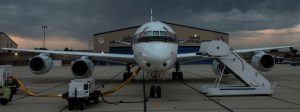The former Douglas airliner is a -72 model, and can stay airborne for 12 hours and has an operational speed between 3-hundred and 5-hundred knots (345-575mph, 555-926kph).
The research flights are made as low as 5-hundred feet (152 meters) and as high as 42-thousand feet (12-thousand-801 meters or 12.80 kilometers).
 DC-8-72 on the ground in Chile after an 11 hours flight to study ocean ice, October 2009.
DC-8-72 on the ground in Chile after an 11 hours flight to study ocean ice, October 2009.
 The information that came with this pic stated the DC-8 was being used to test alternative fuels in California, January 2009.
The information that came with this pic stated the DC-8 was being used to test alternative fuels in California, January 2009.

The DC-8-72 uses a plethora of electronic equipment for remote sensing scientific studies in archeology, ecology, geography, hydrology, meteorology, oceanography, volcanology, atmospheric chemistry, soil science and biology. The name of the organization/university conducting the study is sometimes painted on the forward section of the fuselage, underneath the Dryden Flight Research Center name.
 Preparations for Operation Ice Bridge, Dryden Aircraft Operations Facility, California, late 2009. The cart full of computers is part of a Laser Vegetation Imaging Sensor, waiting to be installed on the DC-8.
Preparations for Operation Ice Bridge, Dryden Aircraft Operations Facility, California, late 2009. The cart full of computers is part of a Laser Vegetation Imaging Sensor, waiting to be installed on the DC-8.
 Inside the DC-8 Airborne Laboratory, being configured for Operation Ice Bridge, 2009.
Inside the DC-8 Airborne Laboratory, being configured for Operation Ice Bridge, 2009.
 DC-8 on approach to Dryden Aircraft Operations Facility, November 2008.
DC-8 on approach to Dryden Aircraft Operations Facility, November 2008.
 From November 1999 to March 2000, the DC-8-72 joined a NASA U-2 (aka ER-2) for SAGE III Ozone Loss and Validation Experiment (SOLVE), in Sweden.
From November 1999 to March 2000, the DC-8-72 joined a NASA U-2 (aka ER-2) for SAGE III Ozone Loss and Validation Experiment (SOLVE), in Sweden.











 In 2019, IDAHO, KANSAS, UTAH were HOME BASES FOR NASA’S DC-8 FIREX-AQ! (also has videos of climate sniffing ops over Germany and Korea)
In 2019, IDAHO, KANSAS, UTAH were HOME BASES FOR NASA’S DC-8 FIREX-AQ! (also has videos of climate sniffing ops over Germany and Korea)
For more info visit NASA’s official DC-8 website
NASA ‘CLIMATE SPY PLANE’ PROVES CALIFORNIA’S STRICT ANTI-POLLUTION LAWS ARE A JOKE!
